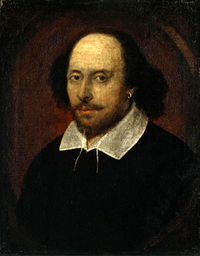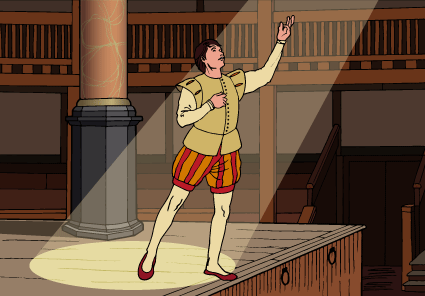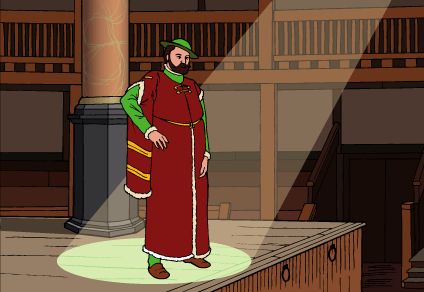Lesson 4.1C: The Bard’s Stories
 It's 1609, and you are 15 years old, uneducated except for what your family has taught you about farming, working hard without complaint, and fending for yourself. You've recently had the good fortune to get a job working as house help for a wealthy widower in London. You've just received your first month's pay, more money than you have seen in all your days - and though you know your family is waiting for you to send some money back home, a friend convinces you to go the Globe Theatre on the other side of the Thames River. William Shakespeare has a new play! On the dusty floor of the gallery, rubbing elbows with the chimney sweeps and the bar maids, you await the entrance of the players. The smell of hot wax fills your nostrils for the stage is surrounded and the hall filled with candles and candelabras. Suddenly a player in the finest fashions enters with a flourish of silks and velvets, and bellows out, "Who's there?" An amazing play begins and your life is never again the same. You have seen theatre, a play, a story come to life. It's 1609, and you are 15 years old, uneducated except for what your family has taught you about farming, working hard without complaint, and fending for yourself. You've recently had the good fortune to get a job working as house help for a wealthy widower in London. You've just received your first month's pay, more money than you have seen in all your days - and though you know your family is waiting for you to send some money back home, a friend convinces you to go the Globe Theatre on the other side of the Thames River. William Shakespeare has a new play! On the dusty floor of the gallery, rubbing elbows with the chimney sweeps and the bar maids, you await the entrance of the players. The smell of hot wax fills your nostrils for the stage is surrounded and the hall filled with candles and candelabras. Suddenly a player in the finest fashions enters with a flourish of silks and velvets, and bellows out, "Who's there?" An amazing play begins and your life is never again the same. You have seen theatre, a play, a story come to life.
William Shakespeare (b.1564 - d.1616), the English poet and playwright, is widely considered to be one of the greatest writers of all time. Renowned for his force of language and perceptive insights into human nature in 38 plays and 154 sonnets, the man is so influential he is often simply referred to as "the Bard," which is an old term for a writer.
Yet, Shakespeare was a simple storyteller at heart. He was a man who liked to entertain his audiences with comedic and tragic characters alike; he enjoyed spinning complex tales of love, war, betrayal, murder, suspense, and imagination. He shared in common with the oral storytellers of the past the pure joy of spinning an elaborate plot, and, in doing so, teaching the audience about themselves and the world around them.
This lesson will give you a basic overview of some of the techniques used in Shakespeare's writing, and give you an opportunity to enjoy one of his most famous soliloquies.
The Play's the Thing!
Drama, or the acting out of stories, naturally evolved out of the ancient tradition of oral storytelling. If one person telling a story is entertaining, it is no surprise that at some point, groups of people decided to tell the story together by acting out the various parts in order to be even more entertaining. Early plays would not have had a script, or printed lines, like they do today. In fact, the earliest known plays of the ancient Greeks had players acting out the parts while poets or singers commented upon their actions from the sidelines.
Over time, drama evolved through many variations - from plays with masks and no words, through plays about myths, plays about the angry gods, plays with music and dance, to plays with all manner of staging and story.
Shakespeare wrote his plays during the English Renaissance (1600 - 1700s), a period of tremendous artistic and cultural development and change. Shakespeare's stories delve into all the deepest of human feelings, and move each generation to be in awe of his perceptive and brilliant reflections on human nature. But what is it, really, that makes Shakespeare so great? Why does everybody know his name, even if they have never read or seen one of his plays?
Shakespeare was a talented poet and some people say that he is the greatest poet that the world has ever known. He was a master of the English language, even inventing hundreds of words and names and turns of phrase that are still used every day. He filled theatres in his day and continues to do so today.

et's explore some of his techniques to better appreciate how he worked his theatrical and literary magic.
To learn about the Shakespearean theatre, go to Will's World and click on Globe Theatre.
All the World’s a Stage - Poetry and Prose in Shakespeare’s Plays
Writing can be classified as either prose or poetry. Prose is writing which has sentences organized into paragraphs. The myths that you read or heard in this first lesson are examples of prose. Poetry, though more difficult to define, tends to use more imagery, and is composed of lines that have a unique pattern when arranged on the page. These lines may be sentences, phrases, or even individual words. Each block of lines in poetry is called a stanza. A ballad is an example of poetry.
Shakespeare's plays contain a blend of both prose writing and poetry. This is part of the reason why sometimes his plays are more challenging to follow. Shakespeare liked to play with the rhythm and rhyme of his character's lines. In fact, he often used the rhythm to indicate what a character's social standing or state of mind was. A king or queen would often have heavily rhythmic lines sometimes with rhyming couplets, while a drunken guard would complain and carry on in plain language.
Blank Verse
Plays written by Shakespeare and his contemporaries were mostly written in a patterned form of poetry called blank verse or rhythmic lines without a rhyme. This type of writing is hard to do - just imagine how hard it would be for Shakespeare to write all his plays this way!

To learn more about Blank Verse, go to the Literary Device Library.
Rhyming Couplets
Shakespeare also liked to use the structure of rhyming couplets, or two lines back to back whose last words rhymed. These line pairings were used in his poetry and plays.
From A Midsummer Night's Dream, where rhyming couplets are used extensively, we get lines like:
When thou hold'st up thy hand. O, let me kiss
This princess of pure white, this seal of bliss!
Or (from the reply)
Can you not hate me, as I know you do,
But you must join in souls to mock me too?
Images
Just as important as language, the use of imagery is central to Shakespeare's work.
For example, when Shakespeare wants you to envision what it is like to be elderly, he describes old age in a way that puts a picture in our minds, an image. Images are created by using detailed and descriptive language that appeal directly to the senses. An image is any vivid or picturesque phrase that evokes a particular picture or feeling in the reader's mind. In the play As You Like It, Shakespeare writes this to describe a the justice: "In fair round belly with good capon line' / With eyes severe and beard of formal cut." What images do you see? Do you picture the man's round belly, severe eyes, and a formally cut beard? This use of a word picture is imagery at work.

As You Like It - A Soliloquy
Let's look closer at Shakespeare's comedy, As You Like It, for more insight into the way that Shakespeare uses language to create a reaction from his audience, and to develop the world of his characters.
Shakespeare used two techniques to reveal the inner thoughts of his characters - an aside and a soliloquy. In an aside, a character breaks away from the other characters on stage and speaks directly to the audience. More commonly, Shakespeare had his main characters alone on stage speaking their innermost thoughts aloud in longer speeches called soliloquies. In As You Like It, the most famous soliloquy is a serious one about the passing of time and aging. The "All the world's a stage" soliloquy, which you will listen to shortly, is a perfect example of how Shakespeare uses rhythm and imagery to create memorable and innovative ways of using language.
 Take a moment now and listen to the soliloquy from As You Like It. You can follow along in your Sightlines 10 on page 247. As you listen, view the images that appear. Watch how the imagery is portrayed visually. Listen carefully, as you will be asked to perform your own dramatic reading of this soliloquy as part of your section assignment. Take a moment now and listen to the soliloquy from As You Like It. You can follow along in your Sightlines 10 on page 247. As you listen, view the images that appear. Watch how the imagery is portrayed visually. Listen carefully, as you will be asked to perform your own dramatic reading of this soliloquy as part of your section assignment.
| Discussion Prompt |
| How many people does it take to write what Shakespeare wrote? There is some debate about whether or not Shakespeare really was the man who created all his plays and poems. Some scholars believe that because he was from the lower classes and did not receive much of an advanced education, that it is not possible for him to have written such great works -they suggest that Shakespeare was merely used as a cover for a wealthy and well-educated person who had no interest in public life. Other critics suggest that more than one person must have written his many works of genius. What do you think? Could one person today with just a high school diploma become a great and prolific writer? Was Shakespeare the real writer? There are many websites to consider-simply enter the terms "Shakespeare authorship" in any search engine. |
Guidelines for contribution:
Take a quick look at some of the websites that outline the authorship debate, and then state whether you believe that Shakespeare was Shakespeare or Shakespeare was someone else. Provide three supporting points for your ideas. You may also choose to include an excerpt from one of the websites. Also, read other students' ideas and respond to at least two other students' thoughts.
Click here to post your forum entry now. |
Summary
Completing this lesson has helped you to:
- differentiate between poetry and prose
- describe a number of dramatic and poetic devices-blank verse, rhyming couplets, an aside, imagery
- read, listen to, and appreciate a Shakespearean soliloquy
- create and perform a dramatic reading
|

